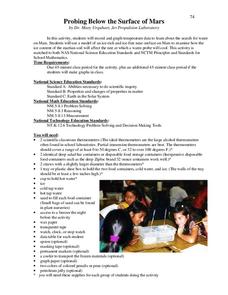Curated OER
Universal Gravitation
Students create a KWL chart about gravity. In this astronomy class, students investigate the nature of gravity. They discuss common misconceptions and address them.
Curated OER
Stellar Discoveries That Are Out of This World
Students hear of the recent discovery of a group of planets orbiting the star Upsilon Andromedae. Each student create a page about an element of the universe,
Curated OER
Solar Cycle
Students explore the solar cycle through a series of experiments. In this space science lesson, students construct and evaluate solar cycle graphs. They explain how this phenomenon affects the Earth.
Curated OER
Probing Below the Surface of Mars
Students simulate the search for water in Mars using simple apparatus. In this space science instructional activity, students explain how soil temperature affects the cooling of probes. They graph the data collected from the simulation.
Curated OER
Why Do We Have Night?
Students engage in a fun, creative way to discover how the Earth moves. This lesson helps students explain why there is day and night. It can also create curiosity to further study the solar system and eclipses!
Curated OER
A Tour of Saturn and Uranus
Second graders draw and label each planet, Saturn and Uranus, showing 2 specific individual characteristics of each.
Curated OER
And a Star to Steer Her By: A Field Trip Guide for the Planetarium Show
In this field trip study guide for the planetarium show lesson, students construct a model of the Earth and describe the relative positions of the continents using latitude and longitude. Students construct a star chart to find...
Curated OER
Biography of a Star: Our Sun's Birth, Life, and Death
Pupils examine how astronomers use parallax to determine the distances of stars in the Sun's neighborhood. They construct a pinhole protractor, and measure angles and calculate distances.
Space Awareness
The Sun Compass of the Vikings
Evidence shows the Vikings likely navigated by using a simple sundial to find their course. Videos, a short story, and discussion help bring this time period to life as they study European history with a hands-on experiment. Scholars...
University of Texas
Lives of Stars
Stars exist from a few million years to over 10 billion years, depending on their mass. Scholars perform a play acting as stars to learn about their different life cycles. They develop an understanding of many of the fundamental concepts...
Space Awareness
Britannia Rule the Waves
Could you determine longitude based on measuring time? Early explorers used a longitude clock to do just that. Scholars learn about early exploration and the importance of the invention of the clock. Then pupils build their own longitude...
Curated OER
Earth Science Lesson Plans on Geologic Time
Springboard your fourth and fifth graders into the study geologic time. They will complete 7 activities to learn about geologic time and the topics most often associated with it: astronomy, creation, planet formation, volcanology,...
Curated OER
How Are Stars Like People?
A beautifully written lesson plan delves into a beautiful topic: stellar population. Engage aspiring astronomers with activities that examine human populations and then transition onto the stars of the universe. Data and photographs for...
Curated OER
Get the Picture!
Astronomers practice downloading data from a high-energy satellite and translate the data into colored or shaded pixels. As a hands-on activity, they use pennies to simulate high-energy satellite data and they convert their penny...
Curated OER
Our Intriguing Star, the Sun!
Explore the sun in a lesson plan about space. The lesson spans ten weeks, with students performing activities to answer weekly questions about the Sun and Earth.
Curated OER
Cosmic Chemistry: An Elemental Question
Space scientists investigate the cosmic phenomena in order to search for answers to possible origins of the solar system. They consider the concepts of elements and isotopes. Data is analyzed looking at tje abundance of elements...
Curated OER
OUT OF THIS WORLD AND INTO OUR CLASSROOM
Students create projects on Astronomy using math concepts and use of Internet resources.
Curated OER
Astronomers
Students explore the profession of astronomy. In this social studies lesson, students read articles on astronomers contributions to society and history. Students reference the Bible for recorded astronomies impact on the...
Curated OER
Where in the World is 5MT?
Students use the Internet to research astronomy questions written by another class. As questions are answered, clues are given telling where the other class is "hiding" in the world.
Curated OER
Celebrating 100 Years of Flight
Students explore the history, science, and journey through flight. They use the Internet to access information in order to participate in active writing assignments. They conduct other activities and build their own virtual plane.
Curated OER
Planet Picking
Students arrange the planets according to their distances from the sun. In this astronomy lesson, students list interesting properties about each planet. They identify an unknown planet photo.
Curated OER
Using Parallax to Determine Distances
Students study parallax and what it is used for. In this distance lesson students complete an activity that allows students to get experience using a parallax.
Curated OER
Mensa For Kids: The Moon
First graders explore space science by completing an arts and crafts activity. In this moon instructional activity, 1st graders explore the geography of the moon and discuss the importance it has for people living on Earth. Students...
Curated OER
Hunting for galaxies in the Hubble Deep Field
Students examine Hubble Deep Field images. In this galaxy classification lesson plan, students research galaxy classification. Students view and classify Hubble Deep field images of galaxies.

























